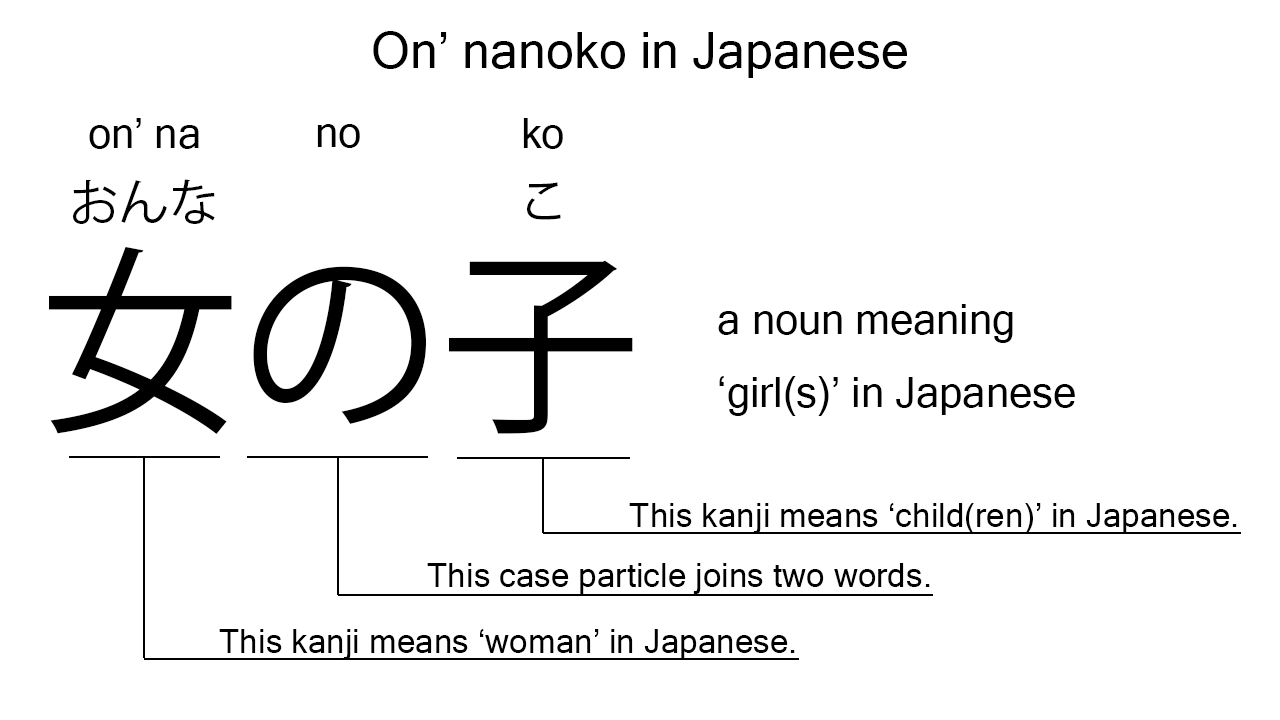What does “on’nanoko” mean in Japanese?
Native speakers say “on’nanoko” to mean ‘girl’ in Japanese. Perhaps, some Japanese learners know this word as it is sometimes used in Japanese movies, songs, novels, manga, anime, and the like. In this blog post, however, I will explain this word in detail based on its kanji expression. And also, I will explain how to use it through example sentences. My explanations would help Japanese learners understand “on’nanoko” more clearly. Then, let’s get started!
Contents
Definition and meaning of “on’nanoko”
Let me start with the definition and meaning of “on’nanoko”.
- on’nanoko – 女の子 (おんなのこ) : a noun meaning ‘girl’ in Japanese. This can also work as plural. Learn more about Japanese plural.
Native speakers use this noun to refer to a girl or girls in Japanese. This noun is more suitable for casual situations than “shoujo“.
The definition and meaning are simple and clear, I think. To understand this noun more clearly, however, let me explain its kanji expression in detail.
On’nanoko in kanji
The kanji expression of “on’nanoko” consists of the following three characters:
- 女 : a kanji character used to mean ‘woman’ or ‘female’ in Japanese.
- の : a case particle joining two nouns. Normally, the first one can work as a modifier to describe the second.
- 子 : a kanji character used to mean ‘child’ or ‘kid’ in Japanese.
These three characters tell us that “on’nanoko” literally means a ‘female child’ in Japanese. This literal interpretation is completely in line with the actual meaning.

When we meet new kanji expressions, we should check their kanji characters in detail to understand their meanings clearly and deeply. In many cases, kanji characters tell us a lot about the meanings of the expressions they form. Actually, here, we could get the better understanding of “on’nanoko” through the detailed kanji check above.
So far, I’ve explained the definition and meaning of “on’nanoko” together with its kanji expression. Then, let me explain how to use it through the example sentences below.
Example #1: how to say “girl” in Japanese
kare wa on’nanoko to umi ni it ta – 彼は女の子と海に行った (かれはおんなのことうみにいった)
He went to the sea with a girl.
Below are the new words used in the example sentence.
- kare – 彼 (かれ) : a pronoun meaning ‘he’ in Japanese.
- wa – は : a binding particle working as a case marker or topic marker. In the example, this works after “kare” to make the subject in the sentence.
- to – と : a case particle used to say with whom someone does something. In the example, this is used after “on’nanoko” to say with whom he went to the sea.
- umi – 海 (うみ) : a noun meaning ‘sea’ or ‘ocean’ in Japanese.
- ni – に : a case particle used to say where someone or something goes. In the example, this is used after “umi” to say where he want.
- it – 行っ (いっ) : one conjugation of the verb, “iku“, which means ‘to go’ in Japanese. In the example, it has been conjugated for the better connection with its following word.
- ta – た : an auxiliary verb used after a verb, adjective, or auxiliary verb to make its past tense form. In the example, this is used after “it” to make its past tense form, “it ta”.
This is a typical usage of “on’nanoko”. In the example, it works together with the case particle, “to”, to say “with a girl” in Japanese.
Example #2: another usage of “on’nanoko”
on’nanoko wa sunahama wo arui ta – 女の子は砂浜を歩いた (おんなのこはすなはまをあるいた)
The girl walked on the beach.
Below are the new words used in the example sentence.
- sunahama – 砂浜 (すなはま) : a noun meaning ‘beach’ in Japanese. This can also work as plural.
- wo – を : a case particle used to make the object word in a sentence. In the example, this is used after “sunahama” to make the object in the sentence.
- arui – 歩い (あるい) : one conjugation of the verb, “aruku“, which means ‘to walk’ in Japanese. In the example, it has been conjugated for the better connection with its following word.
This is another typical usage of “on’nanoko”. In this example, it works together with the binding particle to become the subject in the sentence. When we want to refer to a girl or girls in Japanese, anyway, this noun is a good option.
Summary
In this blog post, I’ve explained the definition and meaning of “on’nanoko” in detail together with its kanji expression. And also, I’ve explained how to use it through the example sentences. Let me summarize them as follows.
- on’nanoko – 女の子 (おんなのこ) : a noun meaning ‘girl’ in Japanese. This can also work as plural. These three characters literally mean a ‘female child’ in Japanese. This literal interpretation is completely in line with the actual meaning. It’s also worth mentioning here that this noun is more suitable for casual situations than “shoujo”.
Hope my explanations are understandable and helpful for Japanese learners.